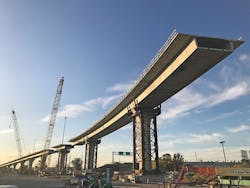NO. 1 BRIDGE: Cline Avenue Bridge
The new Cline Avenue Bridge is an elevated expressway in Northwest Indiana that connects State Highway 912 to I-90, crossing over the Indiana Harbor and Ship Canal in East Chicago, Indiana.
The new bridge is on an existing alignment and replaces a structurally deficient bridge that was closed in November 2009 and then demolished by the Indiana Department of Transportation.
Construction of the new replacement bridge started in July 2017. The new bridge is 6,236 ft long with a 316-ft main span over the Indiana Harbor and Ship Canal, providing 100 ft of vertical and 200 ft of horizontal navigational clearance.
The superstructure is composed of sustainable, post-tensioned concrete, single cell box girders designed with low maintenance features for over a 150-year life. The overall project is 9,850 ft long, which includes connecting the new concrete segmental bridge with a 2,400-ft-long adjacent existing steel beam bridge. Rehabilitation of the existing steel beam bridge occurred concurrently with construction of the new concrete box girder Cline Avenue Bridge.
The project corridor passes through a historically significant steel production region including ArcelorMittal Steel Works. The design and construction team had to consider the potential for contaminated soils and groundwater, especially considering the high-water table (just a few feet below the surface) and uncertainty of slag deposits. The design solution was avoidance of all impacts rather than mitigation.
The project site included numerous wet, dry, and volatile underground utilities; overhead electric lines; and tracks and facilities for multiple railroads. These utilities and railroad facilities required avoidance through design and construction coordination.
To save cost and accelerate construction, it was determined to reuse existing pier locations and, if possible, existing footings and foundations. This resulted in variable span lengths and the evaluation of existing footing and foundation capacities.
The new bridge was designed to accommodate the required variable spans by carefully determining the size and length of each precast superstructure segment while minimizing the number of different length segments. This maximized casting efficiency and saved time by maintaining constant details for the segment casting crews.
Existing footings and foundations were analyzed, and it was determined to install new foundations and footings, but in the same locations as the existing ones. To overcome this challenge, new piling was driven beyond the limits of the existing footings, and new footings were constructed over the existing footings. To ensure no load sharing, the new and existing footings were isolated from each other using compressible materials. This had the added benefit of eliminating excavations.
The schedule for developing the new bridge included obtaining environmental clearances and permitting along with performing design, construction, and ready operation of a tolling infrastructure.
The new superstructure uses precast elements for quality and speed of erection. Superstructure segments are precast under factory-like conditions by local labor within a casting building constructed on site. Concurrently with casting operations, the bridge foundations and substructure were completed and readied for superstructure erection. Abutment construction, roadway, civil, and drainage work also progressed during superstructure precasting. Erection of the bridge superstructure from above using the balanced cantilever method minimized impacts to the access points, railroads, and the Indiana Harbor and Ship Canal below.
“This new 6,236-ft-long bridge was built with local labor and local materials to be a beautiful enhancement to the quality of life making access easier and faster for employment, recreation, and movement of goods and services,” Jay Rohleder, P.E., S.E., project manager for FIGG Bridge Builders, told Roads & Bridges. “The workforce expressed tremendous pride in building this bridge while working to solve many site condition challenges such as a variety of underground utilities, overhead electric lines, and multiple railroad and road crossings through some tough winters.”
